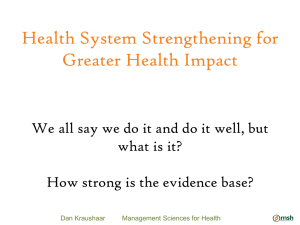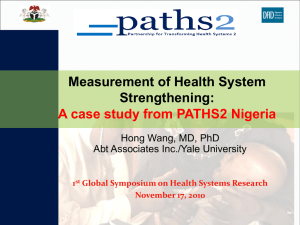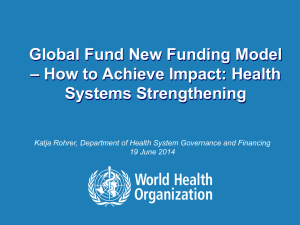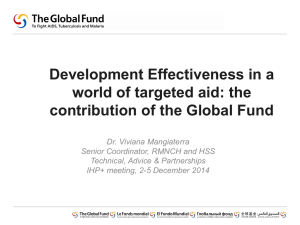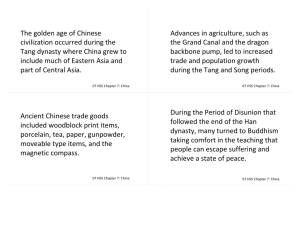Health Systems Strengthening
advertisement
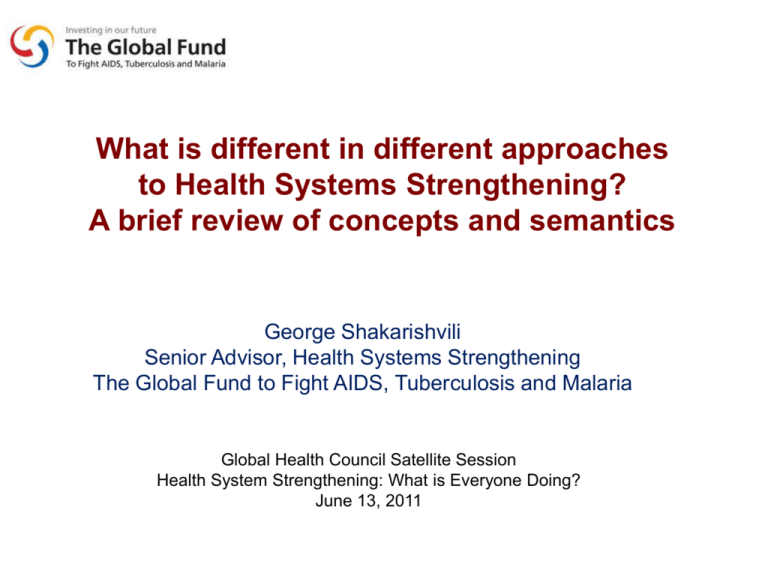
What is different in different approaches to Health Systems Strengthening? A brief review of concepts and semantics George Shakarishvili Senior Advisor, Health Systems Strengthening The Global Fund to Fight AIDS, Tuberculosis and Malaria Global Health Council Satellite Session Health System Strengthening: What is Everyone Doing? June 13, 2011 HSS: A high priority on the global health agenda MDGs: HSS is key for reaching the MDG health targets Evidence: Political support: Research on GHIs G8, H8, HLTF, and other high-level forums Increased demand and supply (2007-2010) World Bank: USD 2.5 billion GFATM: USD 1.7 billion GAVI Alliance: USD 0.8 billion A (false) vertical vs. horizontal dichotomy • 1940s-1950s: Disease eradication campaigns: cholera, smallpox, malaria • 1960s: Paradigm shift: system strengthening approach – (1969): “the most serious health needs can not be met by teams with spraying guns and vaccination syringes.” John Bryant, “Health and the Developing World” • 1970s -1980s: Primary health care – (1978): Alma-Ata Declaration • 1990s: Health financing reforms – (1993): “World Development Report: Investing in Health” • Early 2000s: Disease outbreak and GHIs – Global Fund, GAVI Alliance, Stop TB, UNAIDS, RBM, PEPFAR, PMI… • 2010s: Integration – (2009): Maximizing Positive Synergies between Health Systems and Global Health Initiatives HSS: overly explored, but vaguely defined? An Illustrative List of Health System Frameworks “With the growth of interest in strengthening of health systems, the world now confronts a proliferation of models, strategies, and approaches.” Lancet 2009, 373: 508–15 - Actors framework (Evans, 1981) - Fund flows framework (Hurst, 1991) - Demand-supply framework (Cassels, 1995) - Performance framework (WHO, 2000) “Health system strengthening, the new buzzword in discussions about international health, is in danger of becoming a container concept that is used to label very different interventions.” PLoS Medicine 2009, Vol 6, Issue 4 - Control knobs framework (Hsiao, 2003) - Building blocks framework (WHO, 2007) - Primary care framework (WHO 2008) - Systems framework (Atun, 2008) “There is lack of consensus on what health-system strengthening means, and consequently on how it should be done and evaluated.” Lancet 2010, 377: 1222-23. 6736(10)60679-4 Do definitions matter? • • • • Health system strengthening Operational research, implementation research Quality of care Performance assessment HSS: A single definition or multiple dimensions? Programmatic • Interventions: inputs, processes, policies, etc. leading to outputs, outcomes, and impact Conceptual • Overarching principles: equity, efficiency, sustainability… • External factors: epidemiology, demography, polit-economy... • Systems thinking Operational • • • Health Systems Strengthening Coordination Harmonization Alignment The Global Fund’s HSS portfolio: a means to an end Health system goals: • • • Improving health outcomes (HIV, TB, malaria and also MNCH) Reducing health-related financial risks Increasing customer satisfaction Common weaknesses of HSS funding applications 1. Dissociation of HSS: lack of linkages between proposed HSS interventions and HS goals 2. Fragmented approach to HSS: strengthening specific “building blocks” vs. strengthening the system 3. Verticalization of HSS: HSS is viewed as a separate entity 4. Dis-balanced request for HSS support: over 75% of cross-cutting HSS support was requested for strengthening the service delivery function of the health system vs. 1% for strengthening health financing system 5. Lack of analytical foundation: addressing visible symptoms vs. underlying causes of poor health system performance (how vs. why) Health systems funding platform (GAVI-GFATM-WB-WHO) “Existing financing” Opt 1 Access via common proposal form (GF/GAVI) Opt 2 “New financing” Harmonization of existing HSS support Access via jointly assessed national health strategy (WB/GF/GAVI) Harmonized grant/credit management
